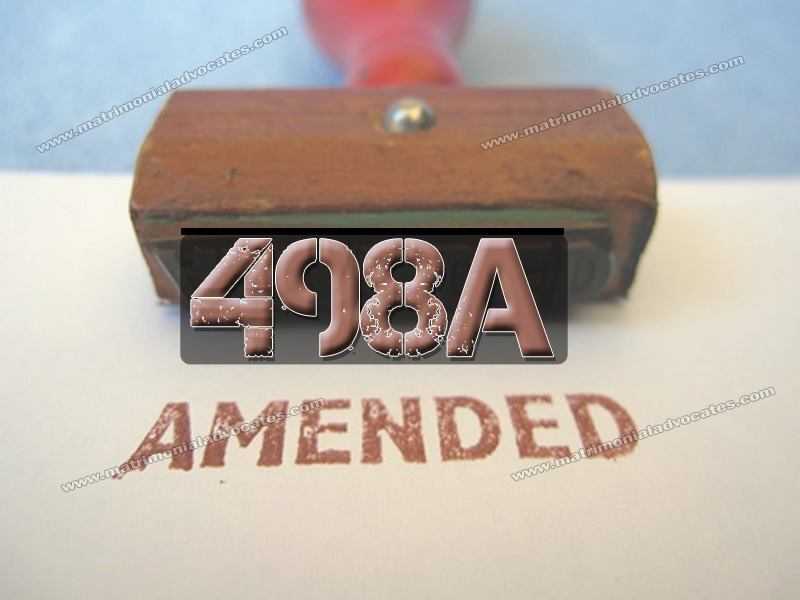
Chapter XII- Offences by Husband and his relatives
498A Husband or relative of husband of a woman subjecting her to cruelty
In 1983, section 498A was introduced to protect a married woman against cruelty inflicted on her by her husband and/or husband’s relatives. This particular section provides protection to women against dowry-related harassment and cruelty.
Though, not every harassment amounts to “cruelty” under section 498A. Only those instances of cruelty which are committed with the intention of coercing a woman or any person related to her to meet any unlawful demand for property, amount to cruelty under this section. {State of A.P. v. M. Madhusudhan Rao (2008) 14 SCC 582}
Such cruelty need not be physical but also includes mental cruelty. What may constitute cruelty for one person may not constitute cruelty for the other.{G.V. Siddaramesh v. State of Karnataka, (2010) 3 SCC 152.}
The concept of cruelty and its effect varies from individual to individual, also depending upon the social and economic status to which such person belongs, Gananath Pattnaik v. State of Orissa, (2002) 2 SCC 619.
It is pertinent to note that only “unlawful demands” as explained under in explanation (b) of Section 498-A. In a case, where a demand of Rs. 10,000 towards repayment of a society loan which is not a dowry demand was not considered sufficient to attract Section 498-A. {Modinsab Kasimsab Kanchagar v. State of Karnataka, (2013) 4 SCC 551}
Supreme Court attempted to define cruelty in the case of Noorjahan v. State (2008) 11 SCC 55. The following definition was given:
“Consequences of cruelty which are likely to drive a woman to commit suicide or to cause grave injury or danger to life, limb or health, whether mental or physical, of the woman is required to be established in order to bring home the application of Section 498 A of IPC.”
Another important factor discussed by the Supreme Court in the present matter was the legislative intent behind section 498A.
“As clearly stated therein the increase in the number of dowry deaths is a matter of serious concern. The extent of the evil has been commented upon by the Joint Committee of the Houses to examine the work of the Dowry Prohibition Act, 1961. In some cases, the cruelty of the husband and the relatives of the husband which culminate in suicide by or murder of the helpless woman concerned, constitute only a small fraction involving such cruelty. Therefore, it was proposed to amend IPC, Code of Criminal Procedure, 1973 and the Evidence Act suitably to deal effectively not only with cases of dowry deaths but also cases of cruelty to married women by the husband, in-laws and relatives. The avowed object is to combat the menace of dowry death and cruelty.”
(emphasis supplied)
Section 498A is the only section which provides recourse to women against the atrocities inflicted on her by her husband and in-laws by making it a criminal offence. Such acts need not constitute only physical abuse but also include mental harassment. In the case of Praveen Mehta v. Inderjit Mehta, the apex court defined mental cruelty as follows:
“Cruelty for the purpose of Section 13(1)(ia) is to be taken as behaviour by one spouse towards the other which causes reasonable apprehension in the mind of the latter that it is not safe for him or her to continue the matrimonial relationship with the other. Mental cruelty is a state of mind and feeling with one of the spouses due to the behaviour or behavioural pattern by the other. Unlike the case of physical cruelty, mental cruelty is difficult to establish by direct evidence. It is necessarily a matter of inference to be drawn from the facts and circumstances of the case. A feeling of anguish, disappointment and frustration in one spouse caused by the conduct of the other can only be appreciated on assessing the attending facts and circumstances in which the two partners of matrimonial life have been living. The inference has to be drawn from the attending facts and circumstances taken cumulatively. In case of mental cruelty, it will not be a correct approach to take an instance of misbehaviour in isolation and then pose the question of whether such behaviour is sufficient by itself to cause mental cruelty. The approach should be to take the cumulative effect of the facts and circumstances emerging from the evidence on record and then draw a fair inference whether the petitioner in the divorce petition has been subjected to mental cruelty due to the conduct of the other.”
The advent of section 498A was triggered to protect helpless women who were regularly getting abused, beaten and tortured by their respective husbands and husband’s family members. However, it was observed by the Court that the section is often used by women more as a weapon than as a shield. Thus, the following decisions below have been taken by the Supreme Court to protect the interests of the husband and his relatives in order to ensure fairness of the trial and proper delivery of justice.
- No immediate arrest
In the case of Arnesh Kumar v. State of Bihar (2014) 8 SCC 273 in order to ensure that the accused are not arrested unnecessarily and that the police officers view such detention in a serious light, in case of complaints under section 498A (i.e. by taking into consideration the humiliation faced by the accused persons so arrested), the following guidelines were issued by the Hon’ble Supreme Court
(a) Police officers not to automatically arrest the accused when a case under 498-A IPC is registered. They should satisfy themselves about the necessity of arrest under parameters flowing from Section 41 CrPC (the judgment lays down the parameters).
(b) Police officers shall fill the checklist (containing specified sub-clauses under Section 41(1)(b)(ii) CrPC) and furnish the reasons and material necessitating the arrest.
(c) The Magistrate will authorise detention only after recording its satisfaction on the report furnished by the police officers.
(d) If the police officers fail to comply with the directions, they will be liable for departmental action as well as punishment for contempt of Court.
(e) Failure of the Judicial Magistrate to comply with the directions will render him liable for departmental action by the appropriate High Court.
- Striking down the establishment of Family Welfare Committees
Through its earlier decision in the case of Rajesh Sharma & Ors. V. State of U.P. & Anr., the Apex court laid down a list of guidelines to prevent misuse of 498A as weapon often wielded by wives against her in-laws. Via this judgment, the Apex court had established Family Welfare Committees which would look prepare a report for every complaint registered under section 498A.
It was made clear by the court in the present case that no arrest shall be made in a matter under section 498A unless a report from the welfare committee is received. Such Family Welfare Committee also was directed to prepare its reports within 1 month of receiving the complaint.
The report thus received would be considered by the Investigating Officer or the Magistrate.
However, the present judgment proved controversial on various grounds including the contention that the Supreme Court had exceeded its jurisdiction and encroached on legislative powers.
Hence, the intrinsic issue that fell for consideration before the Court in the case of Social Action Forum for Manav Adhilkar v. Union of India whether the Court in Rajesh Sharma case could, by the method of interpretation, have issued such directions?
The Three-Judge Bench of the Supreme Court headed by Chief Justice Dipak Misra while holding that Supreme Court’s directions pertaining to Family Welfare Committee and its constitution by the District Legal Services Authority and the power conferred on the Committee is impermissible made the following notable observations in the case:
“In Rajesh Sharma (supra), there is introduction of a third agency which has nothing to do with the Code and that apart, the Committees have been empowered to suggest a report failing which no arrest can be made. The directions to settle a case after it is registered is not a correct expression of law. A criminal proceeding which is not compundable can be quashed by the High Court under Section 482 CrPC. When settlement takes place, then both the parties can file a petition under Section 482 CrPC and the High Court, considering the bonafide of the petition, may quash the same”
Thus, the court struck down the guidelines regarding the constitution of the Family Welfare Committee.
Additionally the following guidelines were laid down by the court in the present case:
- Cases related to section 498A shall be investigated only by a competent designated officer of the area and the same shall be under the superintendent of the senior officer so that the investigating officer does not misuse of abuse his powers.
- It takes away the powers from the district and sessions court to close criminal proceedings in the event of a settlement and the quashing, if any, would by the High Court in accordance with section 482 of Cr.P.C.
- It has retained the condition which relate to anticipatory bail or re-arrest bail, as it is. Thus return of dowry articles is not a precondition for bail.
- If an NRI, facing trial under section 498A, is responding to summons and appearing as and when directed, his privilege to travel for work and stay will not be curtailed.
- However, exemption from personal appearnace , which was taken away by the Rajesh Sharma judgment remains as it is.
- Latest developments
The following developments have taken place with respect to section 498A
- 498A Complaints Can Be Filed At A Place Where A Woman Driven Out Of Matrimonial Home Takes Shelter – Rupali Devi vs. State of UP
- Complaint Need Not Be Filed By The Woman Subjected To Cruelty Herself – Rashmi Chopra vs. State of UP
- Mere Extra-Marital Relationship By Husband Not ‘Cruelty’ To Attract Section 498A/306 IPC – K.V. Prakash Babu vs. State of Karnataka





